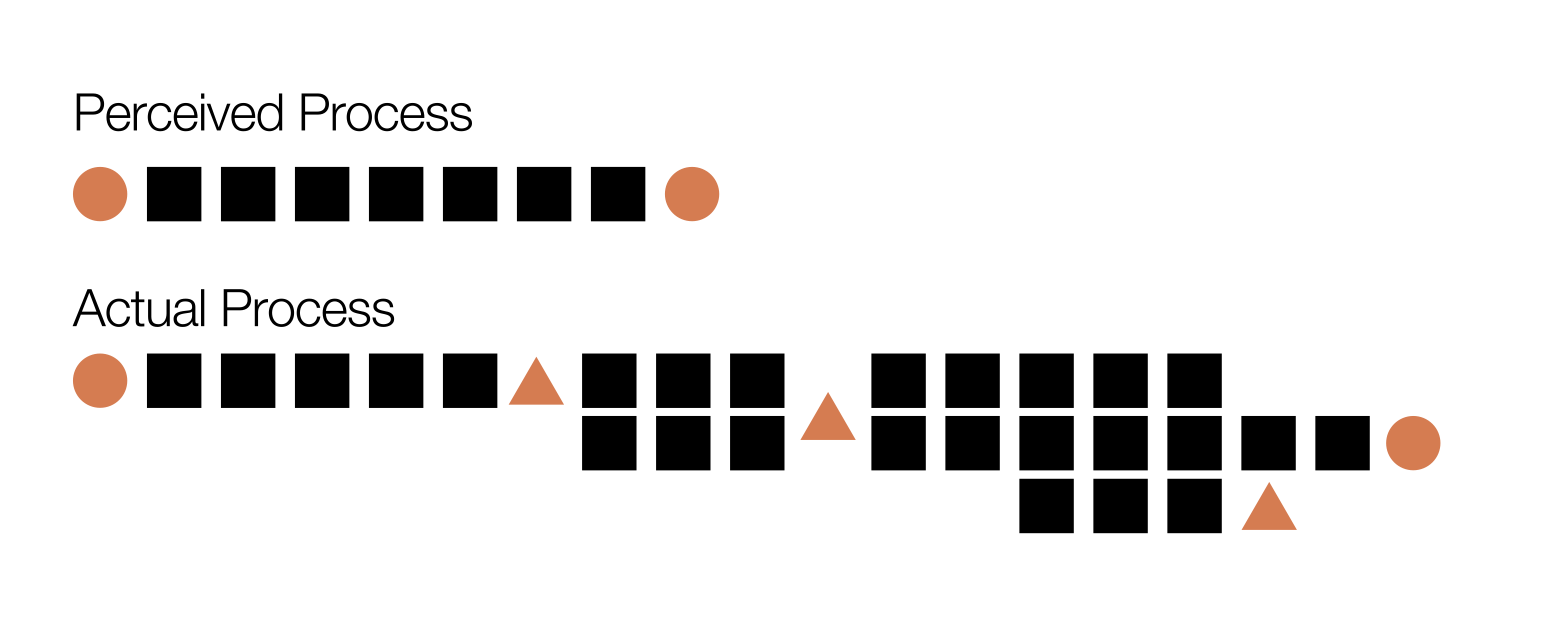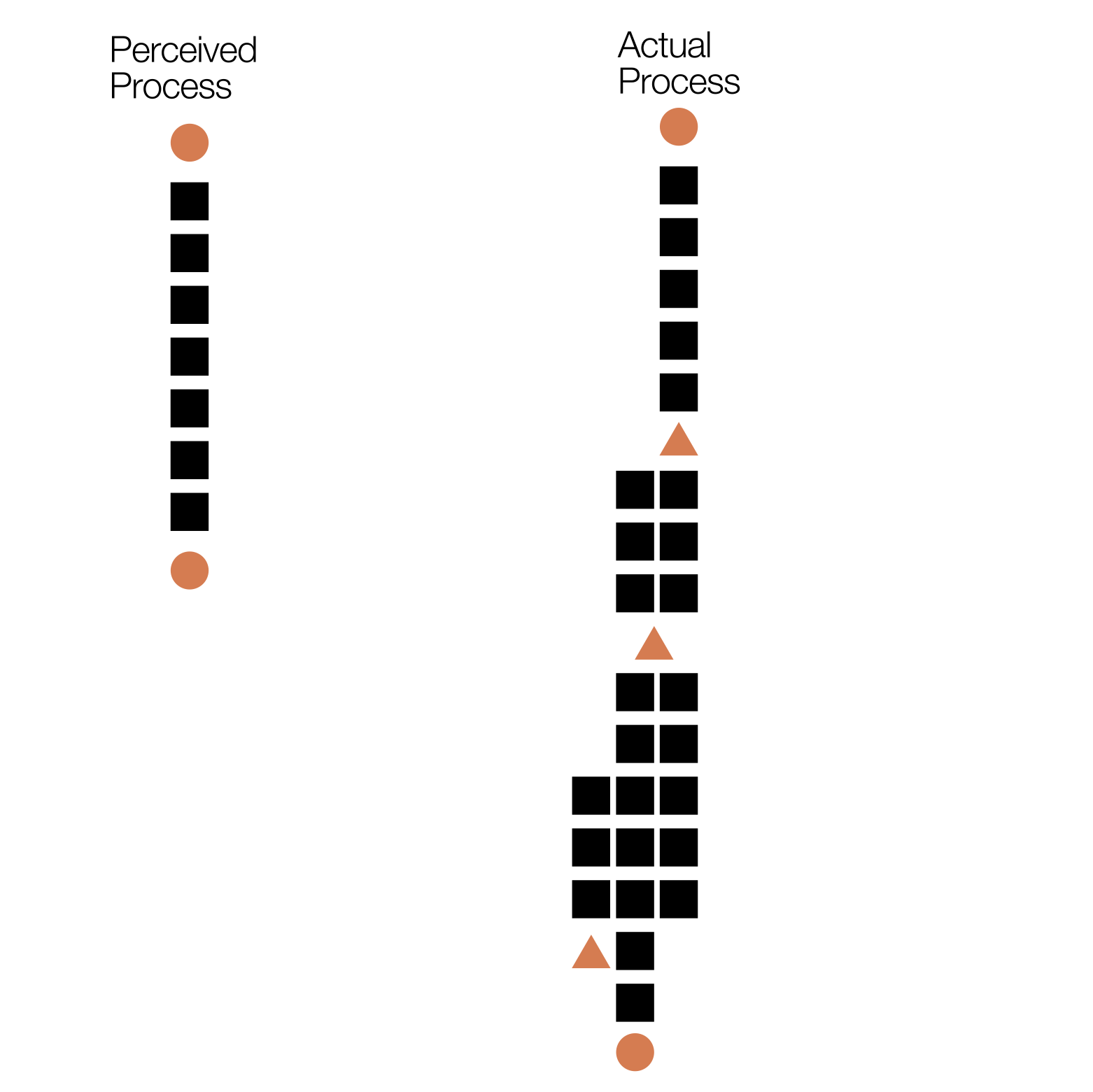Why does it take so long to get documents written, approved and published? In a recent case, we worked with an organization that took 376 days to get a poster with an accompanying memo/briefing note approved but with only 29 days of actual hands-on effort. So what's really going on here?
This video animation illustrates the craziness of these types of processes.
It is frustrating when you ask for something and it takes weeks to appear. There is a good chance that your processes are too complex, have too many steps and require more effort than they need to get the job done.
Here are four challenges that typically result in long review and approval processes:
One Size Fits All: pushing low-risk files into a complex process designed for high-risk files.
We worked with a team to improve the process of writing and publishing a memo. After a review of the types of notes produced, the stages of the process, the length of time it took to get to approval and other data the team found that a typical medium-complexity file took more than 25 hours of effort and four weeks to get to the Chief Executive for approval.
Heavy tracking, numerous levels of review, endless formatting and preventable editing were the main culprits. This level of effort was “necessary” for high-risk, complex files comprising about 60 percent of the workload but for the remaining low-risk files it was a classic case of overprocessing. Instead of defaulting to a one-size-fits-all approach the improvement team built a tasking checklist to ensure that the simplest, lowest effort options were considered, leaving the existing process to handle the more complex files that it was originally designed for.
Is a formal memo the best option? Consider instead:
- Verbal briefing at the next meeting
- Data table
- Diagam
- Other
Over-writing: answering a question posed by the requestor, plus seven other un-asked questions and/or spending as much (or more) time on a document’s formatting as on the content.
Over-writing occurs when the person drafting a document isn’t 100% clear on what question the end-user needs answered and so drafts a longer response to address multiple questions, asked or not. The longer the document, the more likely it is to be over-edited, making the problem even worse. Add to that the compulsion many of us have to spend as much time formatting documents as we do on the content itself and excessive processing relating to document creation and approval can get out of control.
Asking questions upfront about the job a written document is destined to fulfill is a good way to avoid this. Here are some suggestions:
- Ask your client, “what outcome are you hiring this document to accomplish? What problems should it solve?”
- Ask yourself, “what does this document need in order to do that job, or solve that problem?”
- Is a document the right solution? Is this really a value-added output?
- Draft with these questions as your guiding star.
Creating editing guidelines and using templates can reduce effort, number of drafts and elapsed time by up to 50% in the case of one Communications shop we worked with.
Bureaucratic Bloating: when we identify a weakness, we immediately add new controls or reports on top of the existing controls or reports, creating processes that are overly and needlessly heavy.
When something goes wrong in a process, the knee-jerk reaction is put an immediate counter-measure in place to correct the problem. Over time, the new controls are installed on top of old controls from previous generations and presto, bureaucratic bloating takes over and excessive processing kicks in. Similarly, requests for ad-hoc reports have a habit of becoming permanent. One branch with a staff of 50 produced more than 200 regular reports many of which sat unused. The sad part is that delivering these unnecessary reports makes us too busy to take time to identify and eliminate the ones that don’t add value.
The best way to find and eliminate bureaucratic bloating is to make it visible. Map the process. Taking the time to show, visually, the steps in a process will highlight where redundancy occurs. Removal of redundancy will allow for fewer, more effective controls and reports while keeping the auditors happy.
Handoffs: when work gets passed on from one person to another
When someone takes over a piece of work from someone else, the total effort expended is increased. Why? The recipient needs to review the file, ask clarifying questions and get up to speed. Misunderstanding often occurs during the transfer, creating even more work. Instead of breaking a task up into small pieces, consider combining steps to reduce the number of handoffs and the accompanying preventable effort.
These four examples are by no means the only challenges of these processes but they are illustrative of some of what to look for.
Even if you see them happening in your organization and take steps to address them you may need to go a step further and look at the root causes that lead to the excessive processing before you can eliminate it.
Root Cause #1: Lack of trust.
In environments of low trust, processes expand to add more time and effort spent verifying, checking and re-checking. In a high-trust workplace and when the business process is robust enough that it has proven to be trustworthy much of the over-reviewing and controlling drops away. Stephen M.R. Covey’s book “The Speed of Trust: The One Thing that Changes Everything” is required reading on this topic.
Root cause #2: Lack of visibility
Nobody likes to spin their wheels. The previous examples of excessive processing would likely not have occurred if people could have seen what was going on. Mapping the steps in the process, the effort involved and the time it takes makes the issues visible so they can be addressed. It will also expose any differences between the perceived process steps and what actually happens in real-life (see the diagram below). You can’t manage what you can’t see – and if you can’t see it, you probably can’t improve it. Nor can the people you rely on to get the job done. Making the process visible is the first step, and keeping it visible so people stay on track is crucial. Lastly, creating habits like a weekly stand-up meeting to identify and address problems can prevent excessive processing from creeping back onto the scene.
Root cause #3: Overwhelm
“I’m too busy mopping up the floor to turn off the faucet!” When we are overwhelmed by a high volume of work, it is incredibly difficult to understand and remove the root cause of the problem. We go into a kind of hyper-drive trying to get things done without taking the time to consider if there are other, better ways to complete a task.
In this content area, we cover:
- How does Lean and Design Thinking apply to low-volume, document creation processes to deliver more, faster, better and more efficiently?
- What are the principles of Lean document creation, review and approval processes? What are the tools? (interactive hands-on simulations).
- Impacts of flow efficiency versus resource efficiency; invisible processes; absence of proactive learning / problem solving systems
- How to identify Value-Adding/Non-Value-Adding steps
- How to identify the Eight Types of Waste
- How to identify two other sources of waste (Variation, Unreasonableness)
- Data Analysis
- The Six C’s of writing/editing
- Defect Analysis
- Who are the reviewers?
- What criteria are they reviewing? Value added?
- How frequently do each of them observe a “defect”?
- How many times are the same criteria re-assessed?
- Are early steps in the process aware of the criteria by which the document will be assessed?
- How can we create a “review-proof” first draft?
- Root Cause Analysis
- Common issues in these types of processes:
- Unclear Voice of Client, undefined desired outcomes
- Too many review loops
- Invisible workflow
- Too much work in progress
- “Waterfall” development
- Best practices
- Experimentation and Execution



